Introduction
In today's world, the demand for reliable and stable power supply is ever-increasing. Diesel generators have long been a popular choice for backup power generation due to their robustness and ability to provide continuous power in times of need. In recent years, there has been a growing trend towards integrating diesel generators with the main grid to ensure seamless power supply during peak demand periods or in areas with unreliable grid power. This article aims to explore the synchronization of diesel generators with the grid, focusing on the benefits, challenges, and best practices for successful integration.
Overview of Diesel Generators
Diesel generators are a type of combustion engine that converts diesel fuel into mechanical energy, which is then transformed into electrical energy through an alternator. These generators are commonly used in various applications, including standby power for critical facilities, construction sites, events, and remote locations where grid power is unavailable. Diesel generators are known for their reliability, durability, and ability to provide high power outputs for extended periods.
Synchronization with the Grid
Synchronizing a diesel generator with the main grid involves connecting the generator to the grid and ensuring that the two power sources operate in harmony. This process is essential for several reasons, including:
1. Load Sharing: By synchronizing the generator with the grid, the load can be shared between the two power sources, ensuring a stable and reliable power supply.
2. Seamless Transition: Synchronization allows for a smooth transition between grid power and generator power, minimizing disruptions and downtime.
3. 200kw diesel generator Shaving: Diesel generators can assist in reducing peak demand on the grid by supplementing power during periods of high usage, thereby improving overall grid stability.
Benefits of Synchronization
There are several key benefits to synchronizing diesel generators with the grid, including:
1. Enhanced Reliability: By synchronizing with the grid, diesel generators can provide backup power in the event of grid failure, ensuring continuous power supply to critical loads.
2. Cost Savings: Synchronization allows for load sharing between the generator and the grid, optimizing fuel consumption and reducing operational costs.
3. Improved Grid Stability: Diesel generators can help stabilize the grid by providing additional power during peak demand periods or when grid power is insufficient.

4. Environmental Benefits: Synchronizing diesel generators with the grid can reduce overall emissions by allowing for more efficient and cleaner power generation.
Challenges of Synchronization
While there are many benefits to synchronizing diesel generators with the grid, there are also several challenges that must be addressed, including:
1. Control System Compatibility: Ensuring that the control systems of the generator and the grid are compatible is essential for successful synchronization.
2. Voltage and Frequency Matching: Matching the voltage and frequency of the generator with the grid is critical to prevent damage to equipment and ensure reliable power supply.
3. Grid Code Compliance: Meeting the regulatory requirements and grid codes for synchronization can be complex and may require additional equipment or modifications.
4. Maintenance and Monitoring: Regular maintenance and monitoring are essential to ensure that the generator remains in sync with the grid and operates efficiently.
Best Practices for Synchronization
To ensure successful synchronization of diesel generators with the grid, the following best practices should be followed:
1. Conduct a Site Assessment: Before installing a diesel generator for synchronization, conduct a thorough site assessment to determine the power requirements, load characteristics, and grid connection points.
2. Select the Right Generator: Choose a diesel generator that is well-suited for synchronization with the grid, taking into account factors such as power output, fuel efficiency, and emissions.
3. Install Proper Synchronization Equipment: Use quality synchronization equipment, such as synchronizing relays, circuit breakers, and protective devices, to ensure safe and reliable operation.
4. Test and Commissioning: Perform rigorous testing and commissioning of the generator system to verify proper synchronization, voltage and frequency matching, and overall system performance.
5. Train Personnel: Provide training to operators and maintenance staff on proper synchronization procedures, safety protocols, and emergency response measures.
Conclusion
Synchronizing diesel generators with the grid offers numerous benefits in terms of reliability, cost savings, and grid stability. However, it also comes with its own set of challenges that must be carefully addressed to ensure successful integration. By following best practices, conducting thorough site assessments, and investing in quality equipment, businesses and organizations can harness the full potential of diesel generators for grid synchronization and enjoy a more resilient and efficient power supply system.
